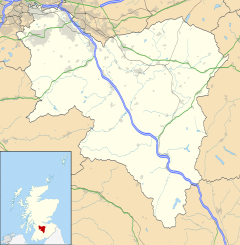New Lanark
| |
|---|---|
 New Lanark Mill Hotel and Waterhouses by River Clyde | |
Location within South Lanarkshire | |
| Population | 200 (approx.) |
| Council area | |
| Lieutenancy area | |
| Country | Scotland |
| Sovereign state | United Kingdom |
| Post town | LANARK |
| Postcode district | ML11 |
| Dialling code | 01555 |
| Police | Scotland |
| Fire | Scottish |
| Ambulance | Scottish |
| UK Parliament | |
| Scottish Parliament | |
| Criteria | Cultural: ii, iv, vi |
| Reference | 429 |
| Inscription | 2001 (25th Session) |
| Area | 146 ha (361 acres) |
| Buffer zone | 667 ha (1,648 acres) |
New Lanark is a village on the River Clyde, approximately 1.4 miles (2.3 kilometres) from Lanark, in Lanarkshire, and some 25 miles (40 km) southeast of Glasgow, Scotland. It was founded in 1785 and opened in 1786 by David Dale, who built cotton mills and housing for the mill workers. Dale built the mills there in a brief partnership with the English inventor and entrepreneur Richard Arkwright to take advantage of the water power provided by the only waterfalls on the River Clyde. Under the ownership of a partnership that included Dale's son-in-law, Robert Owen, a Welsh utopian socialist and philanthropist, New Lanark became a successful business and an early example of a planned settlement and so an important milestone in the historical development of urban planning.[1]
The New Lanark mills operated until 1968. After a period of decline, the New Lanark Conservation Trust (NLCT) was founded in 1974 (now known as the New Lanark Trust (NLT)) to prevent demolition of the village. By 2006 most of the buildings have been restored and the village has become a major tourist attraction. It is one of six UNESCO World Heritage Sites in Scotland[2] and an Anchor Point of ERIH – the European Route of Industrial Heritage.
- ^ Bell, Colin and Rose (1972) City Fathers: The Early History of Town Planning in Britain. Penguin, Harmondsworth.
- ^ "21 World Heritage Sites you have probably never heard of". The Daily Telegraph. 4 February 2016.
